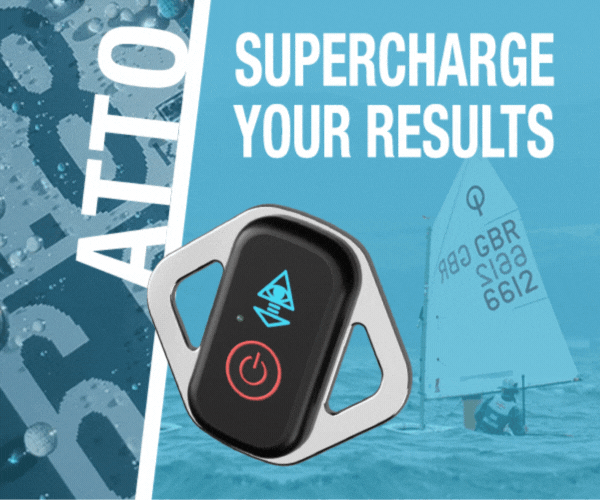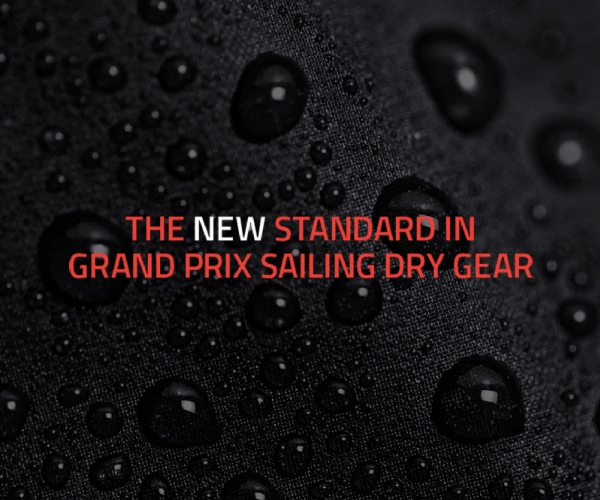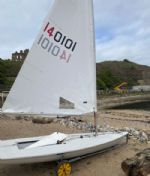












Boats for sale
| Laser 140101 Tynemouth |
 |
| Laser 161752 Tynemouth |
 |
| Laser 28 - Excellent example of this great design Hamble le rice |
 |
List classes of boat for sale |
What defines a skiff? |
Post Reply 
|
Page <1 3456> |
| Author | ||
Chris 249 
Really should get out more 

Joined: 10 May 04 Online Status: Offline Posts: 2041 |
 Post Options Post Options
 Quote Quote  Reply Reply
 Topic: What defines a skiff? Topic: What defines a skiff?Posted: 02 Mar 16 at 10:56am |
|
The 12 Foot Skiff's don't have flat hulls. The "pencil" 18s didn't have wide hulls, nor do many skiffs. The 16 Foot Skiff, from which the term in it current sailing usage basically came, has never had a trapeze for all crew members. The Historical Skiffs have no assy and no trap and don't have flat hulls. (EDIT - whoops, a bit late on the last two). Skiffs weren't even particularly fast when it came to getting into traps, historically.
Edited by Chris 249 - 02 Mar 16 at 10:59am |
||
 |
||
Chris 249 
Really should get out more 

Joined: 10 May 04 Online Status: Offline Posts: 2041 |
 Post Options Post Options
 Quote Quote  Reply Reply
 Posted: 02 Mar 16 at 10:58am Posted: 02 Mar 16 at 10:58am |
|
Boat like the '80s 18 Foot Skiffs, with a 47' (IIRC) mast, did pretty damn well in light winds, and the 12s seem to ghost well under big rigs. And the 12s, 16s, 18s etc seem to have the same high-wind capacity as most high performance boats.
Edited by Chris 249 - 02 Mar 16 at 11:42am |
||
 |
||
Chris 249 
Really should get out more 

Joined: 10 May 04 Online Status: Offline Posts: 2041 |
 Post Options Post Options
 Quote Quote  Reply Reply
 Posted: 02 Mar 16 at 11:24am Posted: 02 Mar 16 at 11:24am |
|
|
Ok, here goes.
The term "skiff" as we know it comes from the classes that first developed in Sydney. The term popped up in the 1870s, in reference to 19 and 22 footers. The "skiff" label came from the fact that these classes had limits on beam (less than 5') and hull depth (less than 20") that kept them closer to the rowing skiff in style, compared to the few bigger and beamier sandbagger type centreboarders. The "skiffs" became the most prominent early replacements for the old "deep keel dinghies" which were basically baby yachts. The "skiffs" were then replaced as the most prominent type by the "fishing boat" 24 footers, which had a minimum beam (not a maximum beam like the skiffs) and were originally fairly cruisey half-decker. They were "a more beamy and weatherly craft" than the skiffs and the old painted and tarred-bottom cruiser/racer "fishing boats" ended up developing into unballasted undecked racing machines by 1876. These were kept ashore so needed no ballast to keep them afloat while on moorings. Because they were kept ashore they could be varnished, and so for a while there was an unusual classification between 24 foot "painted boats" and the 24 foot "varnished boats". The "fishing boats" were the most prominent of what were known as "Open Boats". By the 1880s, the cost of the vast rigs and crews of the 24s was leading people to move into 22 Footers, which of course went down the same route to ever greater beam (50% of the LOA), more sail and more crew. They also became horrendously dangerous, with single capsizes sometimes killing 4 to 9 people. The smaller "open boats", like the 14s, 10s, 8s and 6s were known as "dinghies". All of them had the same sort of rules - only LOA was limited in the early days so beam, rig and crew numbers were vast. However, in some regattas there were classes for "skiffs" which followed the earlier them of having maximum beam and depth, which kept them closer to rowing boats. These did not have the same sort of regular racing as the big "Open boats" and small "dinghies". The expense of the vast rigs and crews encouraged the formation of the first truly organised "skiff" club, which brought in the tightest set of rules ever seen in "Open boat" racing. The club rules (later adopted and modified by the 16 Foot Skiff class) put limits on beam, depth and crew numbers, and sometimes boom length. Sail area limits and more dimensional limits were later introduced on 16s but not 12s, which didn't really take off for decades. As one old 16 Foot Skiff designer said of the early 16s "these really were skiffs" just like rowing watermen's skiffs. Again, what made a boat a "skiff" was the LIMITS, not the freedom. When the 18s developed they were called "18 Footers" and were one of the unrestricted "Open Boat" breed. They followed the normal route to massive rigs and crews, while the 16s were developing into a much more efficient style under their restrictions. This caused a huge ruckus when "skiff type" skinny lightweight boats with flatter sterns (ideas developed in the 16 Foot Skiff class) moved into the 18s and showed them what planing meant. There are pages and pages where fans of the spectacular big-rig old-style 18s sling hate at the "skiff type" 18s, saying that it wasn't speed or open rules that mattered, but just putting on a good show for the crowds in the ferries. The term "skiff" remained largely restricted to 16s and (to a lesser extent) 12s for decades - people like two-time world 18 Footer champ Peter Mander never used the term in his autobiography, referring to them in the usual style of his era just as "18 Footers." It was only in the '70s and '80s that the term started to get used to refer to a general type of boat. The idea that people had "8 foot Skiffs" and "18 Foot Skiffs" in the 1800s and 1920s is just applying a modern term to boats whose owners would have thought it a joke. But throughout the whole evolution of the word, the "skiffs" (not just the 8s, 18s, 22s etc but also the 16s) have always had more righting moment and more sail area per foot than anything that was called a "dinghy" in the northern hemisphere. There has never been (and still is not, as any look at an 18, a 16 and a 12 will show) any such thing as a "skiff shaped hull". Some are rounded, some are flat, some have chines, some don't. They have often been quite retrograde and sometimes slow, at least compared to their sail area and cost. But the basics of a very large rig and high righting moment have been there since the 1800s, and still are today. Personally I dislike the term "skiff" being thrown at anything fast, since that makes the term meaningless and also ignores the enormous importance of conventional dinghies in the development of the modern sailing boat. It's a bit like referring to every fast car as a "Porsche" or "Formula One", even if it's a Mercedes or a world champ rally car. It's about as sensible as it would have been to call Contenders "Flying Dutchman" as a generic term just coz it's kewl and them FDs are sick boat, bro. All of the above is from primary sources. While I liked Frank, his history is often incorrect and quite often (as in his claims about the arrival of the catboat Una in the UK, and much of his information about the sandbaggers) it is completely the opposite of what actually occurred. Edited by Chris 249 - 02 Mar 16 at 11:56am |
||
 |
||
RS400atC 
Really should get out more 
Joined: 04 Dec 08 Online Status: Offline Posts: 3011 |
 Post Options Post Options
 Quote Quote  Reply Reply
 Posted: 02 Mar 16 at 12:38pm Posted: 02 Mar 16 at 12:38pm |
|
I would be interested in references to better historical sources, thanks. |
||
 |
||
Cirrus 
Really should get out more 
Joined: 29 Oct 15 Location: UK Online Status: Offline Posts: 590 |
 Post Options Post Options
 Quote Quote  Reply Reply
 Posted: 02 Mar 16 at 1:22pm Posted: 02 Mar 16 at 1:22pm |
|
What defines a skiff?A. Common and popular usage of the name. Language changes and evolves as does the usage of words..... and will continue to do so. A 'rose by any other name' stuff if you must. |
||
 |
||
andymck 
Far too distracted from work 
Joined: 15 Dec 06 Location: Stamford Online Status: Offline Posts: 397 |
 Post Options Post Options
 Quote Quote  Reply Reply
 Posted: 02 Mar 16 at 1:43pm Posted: 02 Mar 16 at 1:43pm |
|
I am not so convinced. The Murray 18 hull is not easy to sail downwind in big waves, at it became the one design choice as it was more forgiving than its predecessors. I think this is reflected in the places people sail18's. Anyone who has seen the awesome skiff videos or the Beijing 49er debacle will understand. The 12 foot skiffs just look a nightmare in any sort of seaway with the videos that are available. Once you get into the extremes of wind the more conventional boats start to claw back under handicap, non trapeze boats in the light. Or 420 or 505 in a lot. Perhaps we ought to add crew has to be in front of mast in light winds. |
||
|
Andy Mck
|
||
 |
||
Rupert 
Really should get out more 
Joined: 11 Aug 04 Location: Whitefriars sc Online Status: Offline Posts: 8956 |
 Post Options Post Options
 Quote Quote  Reply Reply
 Posted: 02 Mar 16 at 4:22pm Posted: 02 Mar 16 at 4:22pm |
|
|
We can simply this by using the term "skiff-like". We can now, according to most sales blurb or sailing holiday brochure, include every rotomould with an assy kite ever made, any boat with pretensions of speed and even the 2000.
|
||
|
Firefly 2324, Puffin 229, Minisail 3446 Mirror 70686
|
||
 |
||
maxibuddah 
Really should get out more 

Joined: 06 Mar 09 Location: United Kingdom Online Status: Offline Posts: 1760 |
 Post Options Post Options
 Quote Quote  Reply Reply
 Posted: 02 Mar 16 at 4:48pm Posted: 02 Mar 16 at 4:48pm |
|
So what you mean then Rupert is that a skiff should be, by modern definition a planing boat rather than a displacement boat. If that is the case then discuss what constitutes planing...that hasn't been done in a couple of years 
|
||
|
Everything I say is my opinion, honest
|
||
 |
||
Rupert 
Really should get out more 
Joined: 11 Aug 04 Location: Whitefriars sc Online Status: Offline Posts: 8956 |
 Post Options Post Options
 Quote Quote  Reply Reply
 Posted: 02 Mar 16 at 4:50pm Posted: 02 Mar 16 at 4:50pm |
|
|
I don't think we have ever managed to define the word Dinghy on here, let alone planing.
|
||
|
Firefly 2324, Puffin 229, Minisail 3446 Mirror 70686
|
||
 |
||
realnutter 
Posting king 
Joined: 17 Nov 15 Location: Reading, UK Online Status: Offline Posts: 129 |
 Post Options Post Options
 Quote Quote  Reply Reply
 Posted: 02 Mar 16 at 5:25pm Posted: 02 Mar 16 at 5:25pm |
|
|
Just to add to the confusion, there's the Norfolk Punt, which looks like a giant canoe, but flies an assy, and has both helm and crew on traps...
|
||
 |
||
Post Reply 
|
Page <1 3456> |
| Forum Jump | Forum Permissions  You cannot post new topics in this forum You cannot reply to topics in this forum You cannot delete your posts in this forum You cannot edit your posts in this forum You cannot create polls in this forum You cannot vote in polls in this forum |
Bulletin Board Software by Web Wiz Forums® version 9.665y
Copyright ©2001-2010 Web Wiz
Change your personal settings, or read our privacy policy
Copyright ©2001-2010 Web Wiz
Change your personal settings, or read our privacy policy











 Printable Version
Printable Version Delicious
Delicious Digg
Digg Facebook
Facebook Furl
Furl Google
Google MySpace
MySpace Newsvine
Newsvine reddit
reddit StumbleUpon
StumbleUpon Twitter
Twitter Windows Live
Windows Live Yahoo Bookmarks
Yahoo Bookmarks Topic Options
Topic Options